Analysis of Statecraft and Diplomacy in Freeman's 'Arts of Power'
VerifiedAdded on 2023/06/12
|11
|2486
|156
Report
AI Summary
This assignment is a book review of Charles Freeman's 'Arts of Power: Statecraft and Diplomacy,' critically assessing the author's objectives, theoretical framework, key concepts, central argument, methodology, evidence, values, contribution to the wider literature, style, and overall conclusion. The review explores Freeman's multicultural perspective on foreign policy and diplomacy, his emphasis on negotiation, and his analysis of state power, diplomatic maneuvers, and skills. It also critiques the book's limitations, such as its need for updates on contemporary global issues like cybercrime and the rise of new superpowers, and its limited focus on the business sector. The review concludes by discussing the book's contribution to understanding the role of diplomats in international politics and its relevance to modern-day diplomacy, highlighting the influence of Freeman's background on his conceptualization.
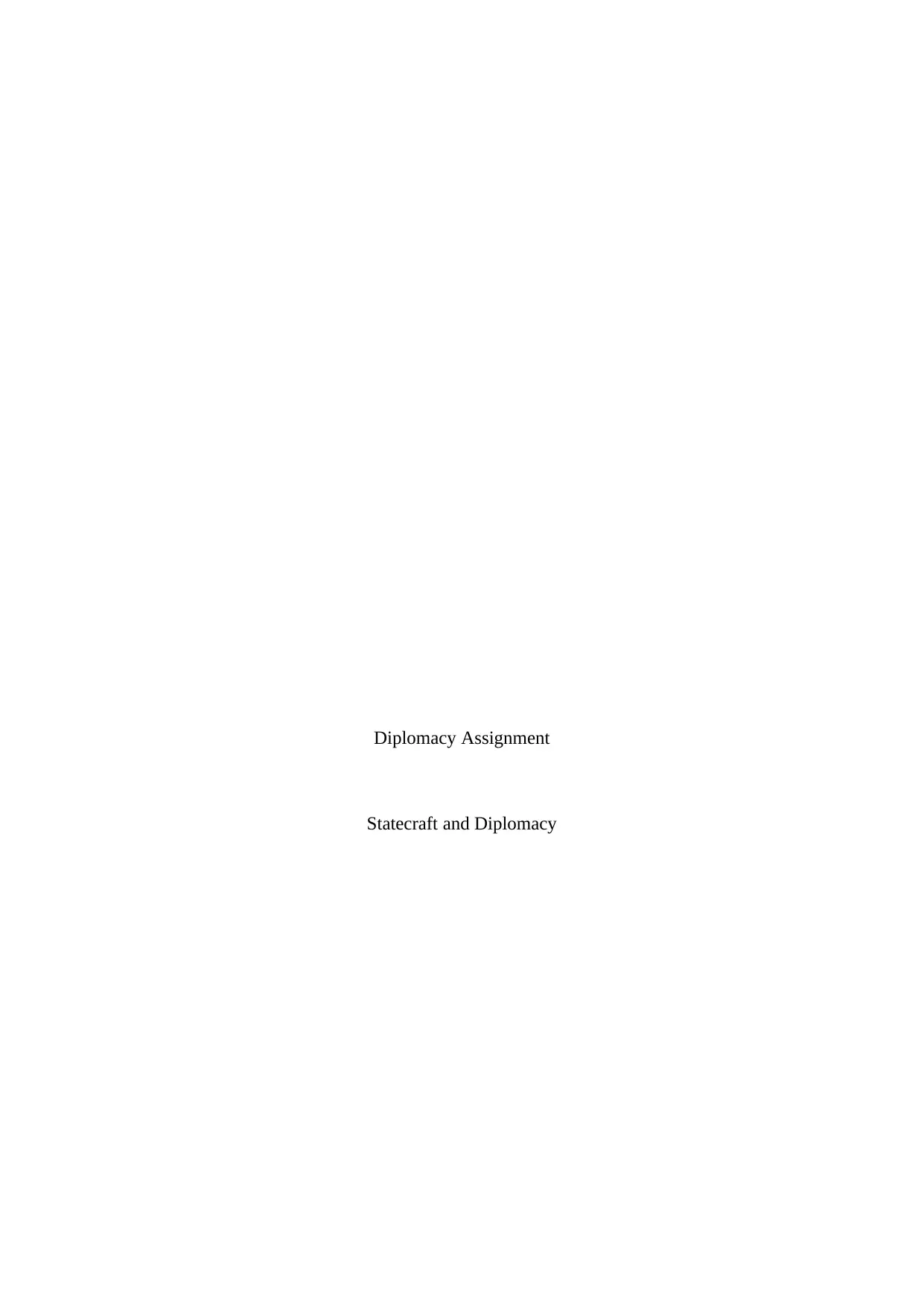
Diplomacy Assignment
Statecraft and Diplomacy
Statecraft and Diplomacy
Paraphrase This Document
Need a fresh take? Get an instant paraphrase of this document with our AI Paraphraser
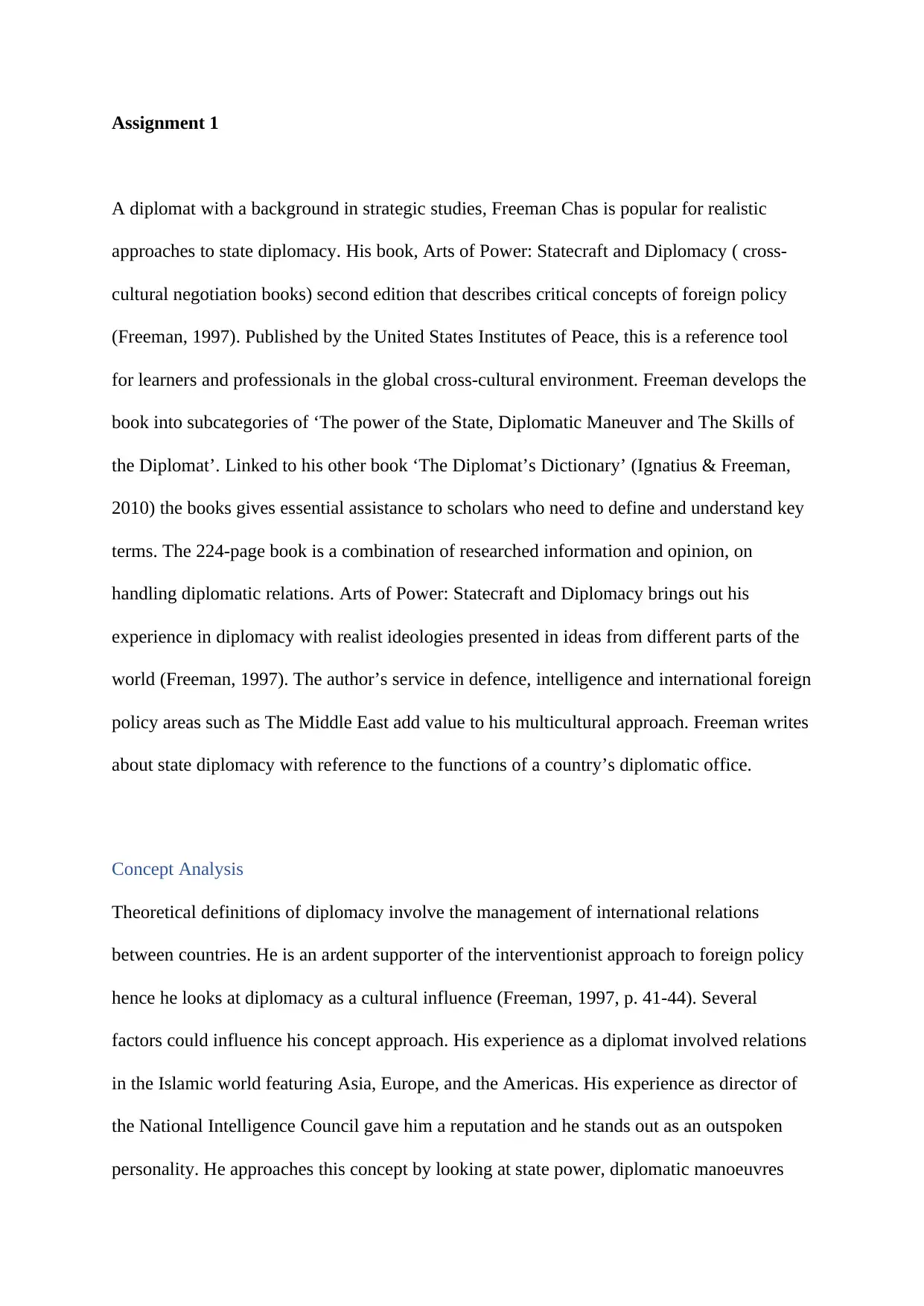
Assignment 1
A diplomat with a background in strategic studies, Freeman Chas is popular for realistic
approaches to state diplomacy. His book, Arts of Power: Statecraft and Diplomacy ( cross-
cultural negotiation books) second edition that describes critical concepts of foreign policy
(Freeman, 1997). Published by the United States Institutes of Peace, this is a reference tool
for learners and professionals in the global cross-cultural environment. Freeman develops the
book into subcategories of ‘The power of the State, Diplomatic Maneuver and The Skills of
the Diplomat’. Linked to his other book ‘The Diplomat’s Dictionary’ (Ignatius & Freeman,
2010) the books gives essential assistance to scholars who need to define and understand key
terms. The 224-page book is a combination of researched information and opinion, on
handling diplomatic relations. Arts of Power: Statecraft and Diplomacy brings out his
experience in diplomacy with realist ideologies presented in ideas from different parts of the
world (Freeman, 1997). The author’s service in defence, intelligence and international foreign
policy areas such as The Middle East add value to his multicultural approach. Freeman writes
about state diplomacy with reference to the functions of a country’s diplomatic office.
Concept Analysis
Theoretical definitions of diplomacy involve the management of international relations
between countries. He is an ardent supporter of the interventionist approach to foreign policy
hence he looks at diplomacy as a cultural influence (Freeman, 1997, p. 41-44). Several
factors could influence his concept approach. His experience as a diplomat involved relations
in the Islamic world featuring Asia, Europe, and the Americas. His experience as director of
the National Intelligence Council gave him a reputation and he stands out as an outspoken
personality. He approaches this concept by looking at state power, diplomatic manoeuvres
A diplomat with a background in strategic studies, Freeman Chas is popular for realistic
approaches to state diplomacy. His book, Arts of Power: Statecraft and Diplomacy ( cross-
cultural negotiation books) second edition that describes critical concepts of foreign policy
(Freeman, 1997). Published by the United States Institutes of Peace, this is a reference tool
for learners and professionals in the global cross-cultural environment. Freeman develops the
book into subcategories of ‘The power of the State, Diplomatic Maneuver and The Skills of
the Diplomat’. Linked to his other book ‘The Diplomat’s Dictionary’ (Ignatius & Freeman,
2010) the books gives essential assistance to scholars who need to define and understand key
terms. The 224-page book is a combination of researched information and opinion, on
handling diplomatic relations. Arts of Power: Statecraft and Diplomacy brings out his
experience in diplomacy with realist ideologies presented in ideas from different parts of the
world (Freeman, 1997). The author’s service in defence, intelligence and international foreign
policy areas such as The Middle East add value to his multicultural approach. Freeman writes
about state diplomacy with reference to the functions of a country’s diplomatic office.
Concept Analysis
Theoretical definitions of diplomacy involve the management of international relations
between countries. He is an ardent supporter of the interventionist approach to foreign policy
hence he looks at diplomacy as a cultural influence (Freeman, 1997, p. 41-44). Several
factors could influence his concept approach. His experience as a diplomat involved relations
in the Islamic world featuring Asia, Europe, and the Americas. His experience as director of
the National Intelligence Council gave him a reputation and he stands out as an outspoken
personality. He approaches this concept by looking at state power, diplomatic manoeuvres
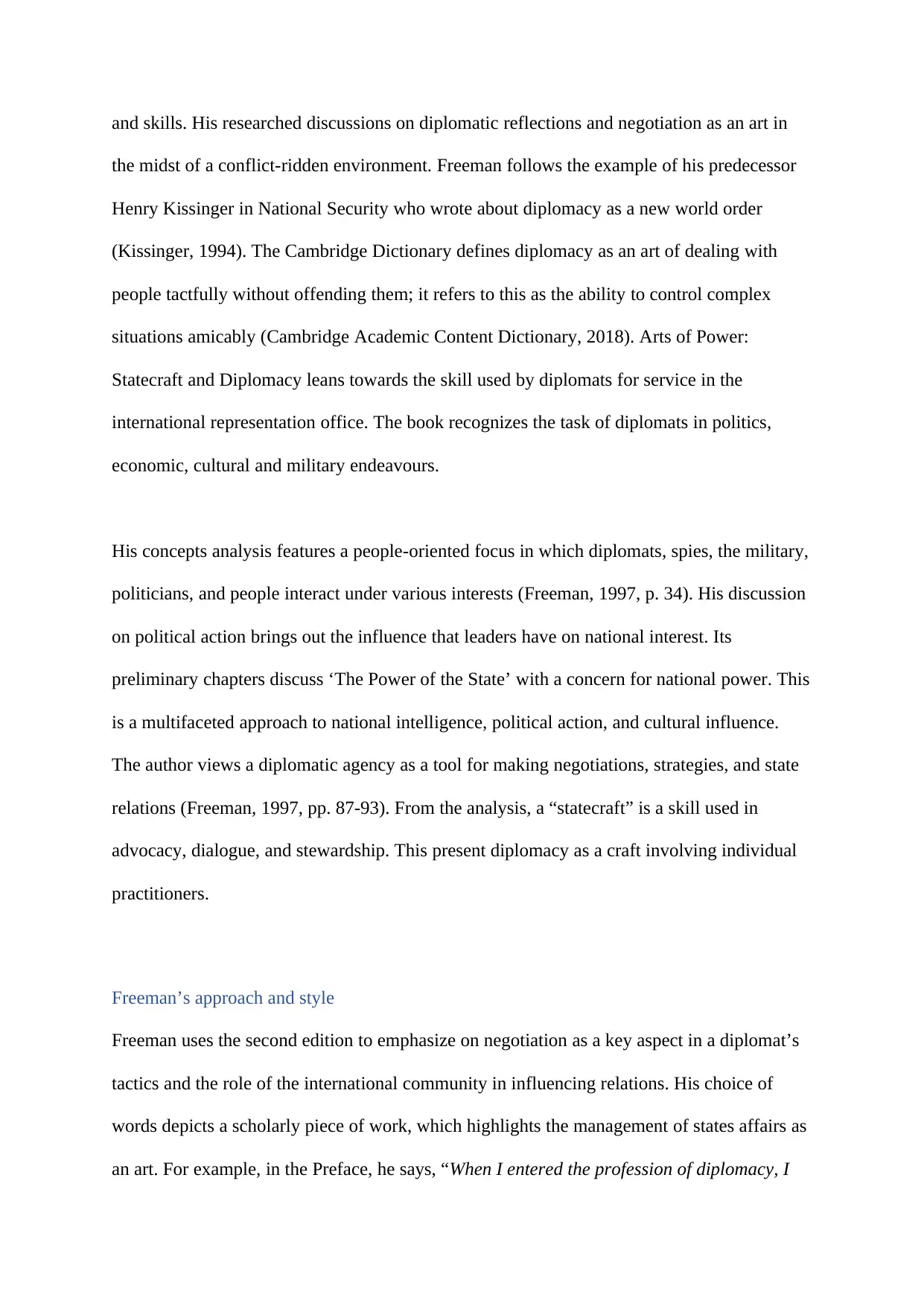
and skills. His researched discussions on diplomatic reflections and negotiation as an art in
the midst of a conflict-ridden environment. Freeman follows the example of his predecessor
Henry Kissinger in National Security who wrote about diplomacy as a new world order
(Kissinger, 1994). The Cambridge Dictionary defines diplomacy as an art of dealing with
people tactfully without offending them; it refers to this as the ability to control complex
situations amicably (Cambridge Academic Content Dictionary, 2018). Arts of Power:
Statecraft and Diplomacy leans towards the skill used by diplomats for service in the
international representation office. The book recognizes the task of diplomats in politics,
economic, cultural and military endeavours.
His concepts analysis features a people-oriented focus in which diplomats, spies, the military,
politicians, and people interact under various interests (Freeman, 1997, p. 34). His discussion
on political action brings out the influence that leaders have on national interest. Its
preliminary chapters discuss ‘The Power of the State’ with a concern for national power. This
is a multifaceted approach to national intelligence, political action, and cultural influence.
The author views a diplomatic agency as a tool for making negotiations, strategies, and state
relations (Freeman, 1997, pp. 87-93). From the analysis, a “statecraft” is a skill used in
advocacy, dialogue, and stewardship. This present diplomacy as a craft involving individual
practitioners.
Freeman’s approach and style
Freeman uses the second edition to emphasize on negotiation as a key aspect in a diplomat’s
tactics and the role of the international community in influencing relations. His choice of
words depicts a scholarly piece of work, which highlights the management of states affairs as
an art. For example, in the Preface, he says, “When I entered the profession of diplomacy, I
the midst of a conflict-ridden environment. Freeman follows the example of his predecessor
Henry Kissinger in National Security who wrote about diplomacy as a new world order
(Kissinger, 1994). The Cambridge Dictionary defines diplomacy as an art of dealing with
people tactfully without offending them; it refers to this as the ability to control complex
situations amicably (Cambridge Academic Content Dictionary, 2018). Arts of Power:
Statecraft and Diplomacy leans towards the skill used by diplomats for service in the
international representation office. The book recognizes the task of diplomats in politics,
economic, cultural and military endeavours.
His concepts analysis features a people-oriented focus in which diplomats, spies, the military,
politicians, and people interact under various interests (Freeman, 1997, p. 34). His discussion
on political action brings out the influence that leaders have on national interest. Its
preliminary chapters discuss ‘The Power of the State’ with a concern for national power. This
is a multifaceted approach to national intelligence, political action, and cultural influence.
The author views a diplomatic agency as a tool for making negotiations, strategies, and state
relations (Freeman, 1997, pp. 87-93). From the analysis, a “statecraft” is a skill used in
advocacy, dialogue, and stewardship. This present diplomacy as a craft involving individual
practitioners.
Freeman’s approach and style
Freeman uses the second edition to emphasize on negotiation as a key aspect in a diplomat’s
tactics and the role of the international community in influencing relations. His choice of
words depicts a scholarly piece of work, which highlights the management of states affairs as
an art. For example, in the Preface, he says, “When I entered the profession of diplomacy, I
⊘ This is a preview!⊘
Do you want full access?
Subscribe today to unlock all pages.

Trusted by 1+ million students worldwide
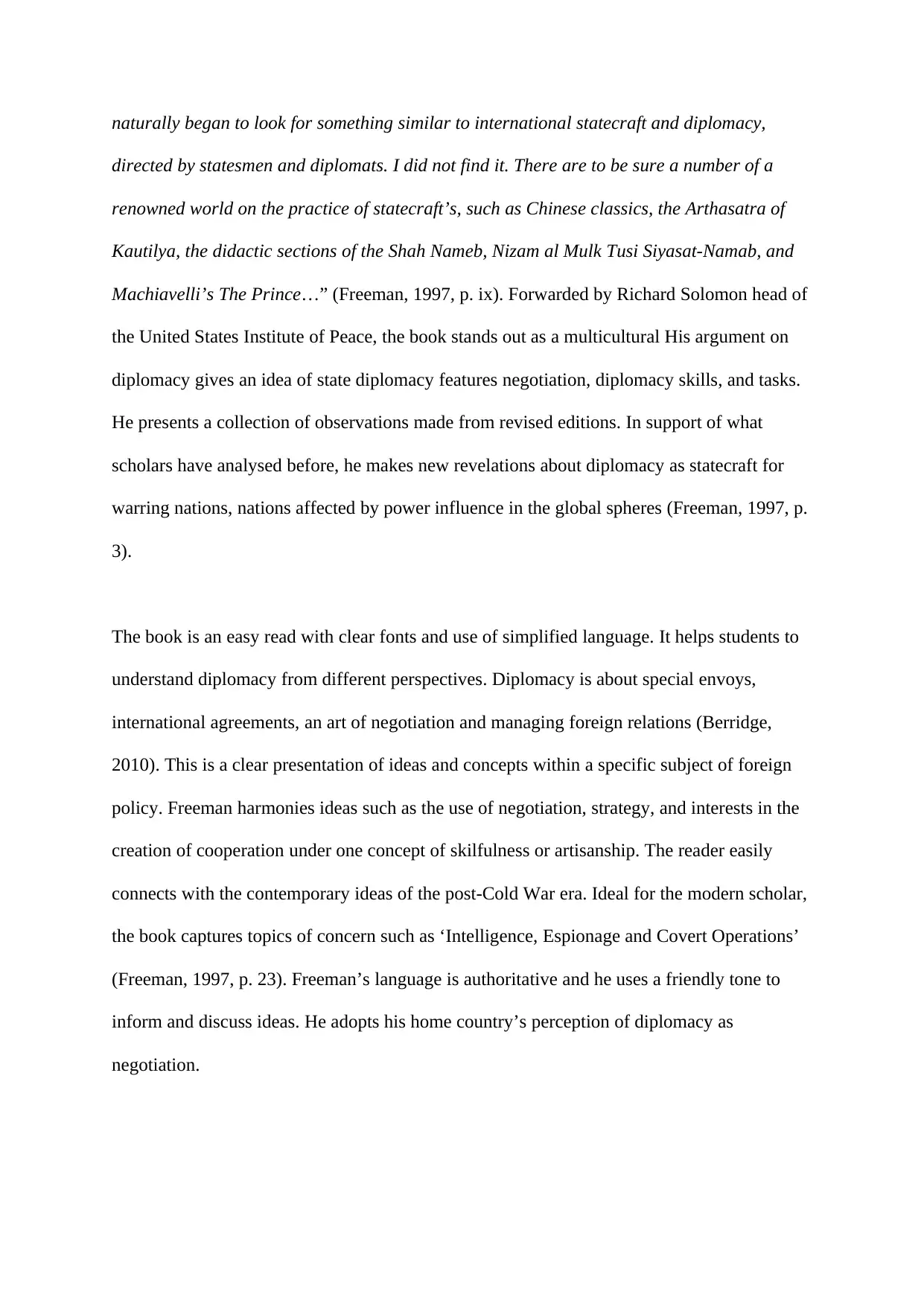
naturally began to look for something similar to international statecraft and diplomacy,
directed by statesmen and diplomats. I did not find it. There are to be sure a number of a
renowned world on the practice of statecraft’s, such as Chinese classics, the Arthasatra of
Kautilya, the didactic sections of the Shah Nameb, Nizam al Mulk Tusi Siyasat-Namab, and
Machiavelli’s The Prince…” (Freeman, 1997, p. ix). Forwarded by Richard Solomon head of
the United States Institute of Peace, the book stands out as a multicultural His argument on
diplomacy gives an idea of state diplomacy features negotiation, diplomacy skills, and tasks.
He presents a collection of observations made from revised editions. In support of what
scholars have analysed before, he makes new revelations about diplomacy as statecraft for
warring nations, nations affected by power influence in the global spheres (Freeman, 1997, p.
3).
The book is an easy read with clear fonts and use of simplified language. It helps students to
understand diplomacy from different perspectives. Diplomacy is about special envoys,
international agreements, an art of negotiation and managing foreign relations (Berridge,
2010). This is a clear presentation of ideas and concepts within a specific subject of foreign
policy. Freeman harmonies ideas such as the use of negotiation, strategy, and interests in the
creation of cooperation under one concept of skilfulness or artisanship. The reader easily
connects with the contemporary ideas of the post-Cold War era. Ideal for the modern scholar,
the book captures topics of concern such as ‘Intelligence, Espionage and Covert Operations’
(Freeman, 1997, p. 23). Freeman’s language is authoritative and he uses a friendly tone to
inform and discuss ideas. He adopts his home country’s perception of diplomacy as
negotiation.
directed by statesmen and diplomats. I did not find it. There are to be sure a number of a
renowned world on the practice of statecraft’s, such as Chinese classics, the Arthasatra of
Kautilya, the didactic sections of the Shah Nameb, Nizam al Mulk Tusi Siyasat-Namab, and
Machiavelli’s The Prince…” (Freeman, 1997, p. ix). Forwarded by Richard Solomon head of
the United States Institute of Peace, the book stands out as a multicultural His argument on
diplomacy gives an idea of state diplomacy features negotiation, diplomacy skills, and tasks.
He presents a collection of observations made from revised editions. In support of what
scholars have analysed before, he makes new revelations about diplomacy as statecraft for
warring nations, nations affected by power influence in the global spheres (Freeman, 1997, p.
3).
The book is an easy read with clear fonts and use of simplified language. It helps students to
understand diplomacy from different perspectives. Diplomacy is about special envoys,
international agreements, an art of negotiation and managing foreign relations (Berridge,
2010). This is a clear presentation of ideas and concepts within a specific subject of foreign
policy. Freeman harmonies ideas such as the use of negotiation, strategy, and interests in the
creation of cooperation under one concept of skilfulness or artisanship. The reader easily
connects with the contemporary ideas of the post-Cold War era. Ideal for the modern scholar,
the book captures topics of concern such as ‘Intelligence, Espionage and Covert Operations’
(Freeman, 1997, p. 23). Freeman’s language is authoritative and he uses a friendly tone to
inform and discuss ideas. He adopts his home country’s perception of diplomacy as
negotiation.
Paraphrase This Document
Need a fresh take? Get an instant paraphrase of this document with our AI Paraphraser
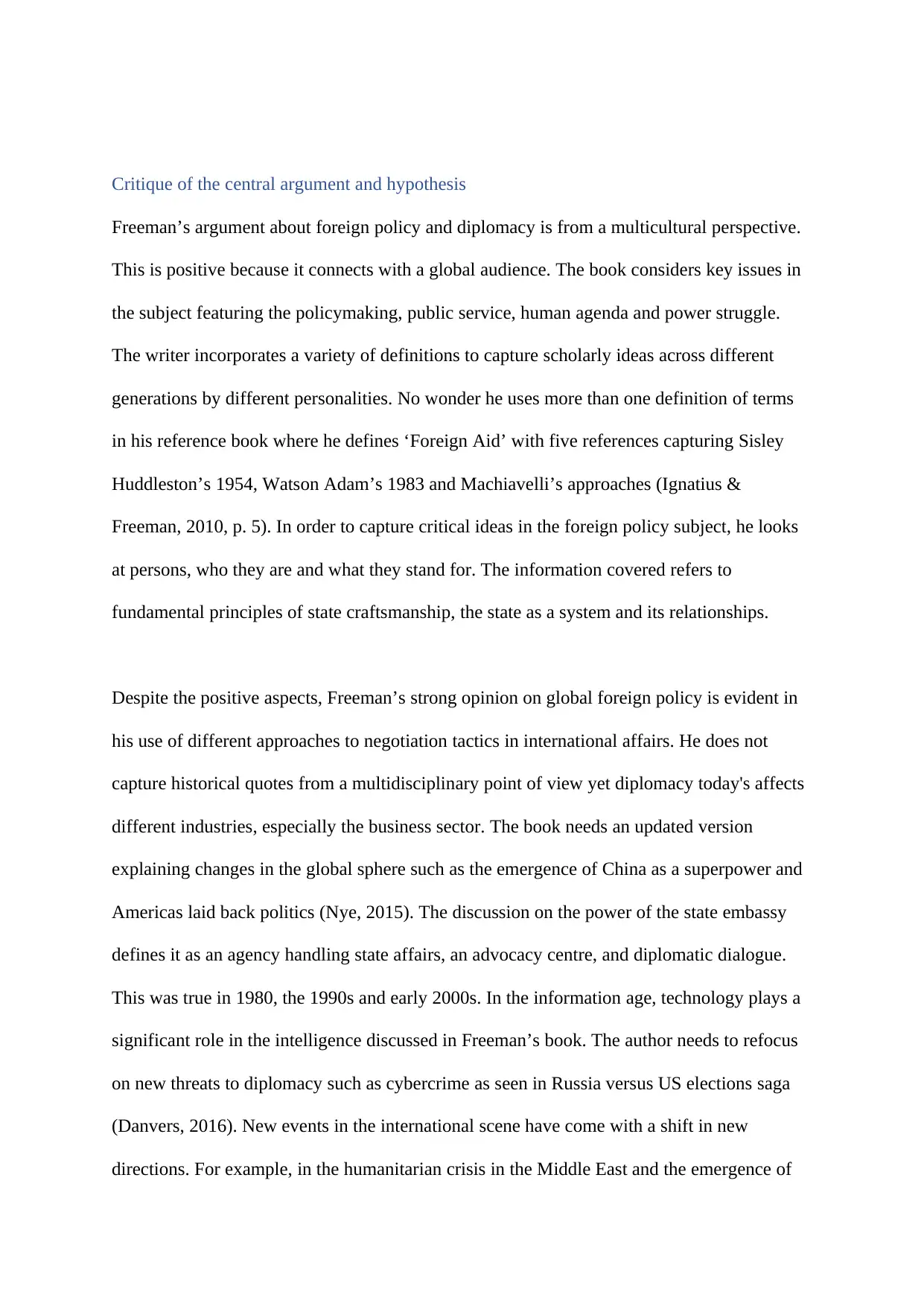
Critique of the central argument and hypothesis
Freeman’s argument about foreign policy and diplomacy is from a multicultural perspective.
This is positive because it connects with a global audience. The book considers key issues in
the subject featuring the policymaking, public service, human agenda and power struggle.
The writer incorporates a variety of definitions to capture scholarly ideas across different
generations by different personalities. No wonder he uses more than one definition of terms
in his reference book where he defines ‘Foreign Aid’ with five references capturing Sisley
Huddleston’s 1954, Watson Adam’s 1983 and Machiavelli’s approaches (Ignatius &
Freeman, 2010, p. 5). In order to capture critical ideas in the foreign policy subject, he looks
at persons, who they are and what they stand for. The information covered refers to
fundamental principles of state craftsmanship, the state as a system and its relationships.
Despite the positive aspects, Freeman’s strong opinion on global foreign policy is evident in
his use of different approaches to negotiation tactics in international affairs. He does not
capture historical quotes from a multidisciplinary point of view yet diplomacy today's affects
different industries, especially the business sector. The book needs an updated version
explaining changes in the global sphere such as the emergence of China as a superpower and
Americas laid back politics (Nye, 2015). The discussion on the power of the state embassy
defines it as an agency handling state affairs, an advocacy centre, and diplomatic dialogue.
This was true in 1980, the 1990s and early 2000s. In the information age, technology plays a
significant role in the intelligence discussed in Freeman’s book. The author needs to refocus
on new threats to diplomacy such as cybercrime as seen in Russia versus US elections saga
(Danvers, 2016). New events in the international scene have come with a shift in new
directions. For example, in the humanitarian crisis in the Middle East and the emergence of
Freeman’s argument about foreign policy and diplomacy is from a multicultural perspective.
This is positive because it connects with a global audience. The book considers key issues in
the subject featuring the policymaking, public service, human agenda and power struggle.
The writer incorporates a variety of definitions to capture scholarly ideas across different
generations by different personalities. No wonder he uses more than one definition of terms
in his reference book where he defines ‘Foreign Aid’ with five references capturing Sisley
Huddleston’s 1954, Watson Adam’s 1983 and Machiavelli’s approaches (Ignatius &
Freeman, 2010, p. 5). In order to capture critical ideas in the foreign policy subject, he looks
at persons, who they are and what they stand for. The information covered refers to
fundamental principles of state craftsmanship, the state as a system and its relationships.
Despite the positive aspects, Freeman’s strong opinion on global foreign policy is evident in
his use of different approaches to negotiation tactics in international affairs. He does not
capture historical quotes from a multidisciplinary point of view yet diplomacy today's affects
different industries, especially the business sector. The book needs an updated version
explaining changes in the global sphere such as the emergence of China as a superpower and
Americas laid back politics (Nye, 2015). The discussion on the power of the state embassy
defines it as an agency handling state affairs, an advocacy centre, and diplomatic dialogue.
This was true in 1980, the 1990s and early 2000s. In the information age, technology plays a
significant role in the intelligence discussed in Freeman’s book. The author needs to refocus
on new threats to diplomacy such as cybercrime as seen in Russia versus US elections saga
(Danvers, 2016). New events in the international scene have come with a shift in new
directions. For example, in the humanitarian crisis in the Middle East and the emergence of
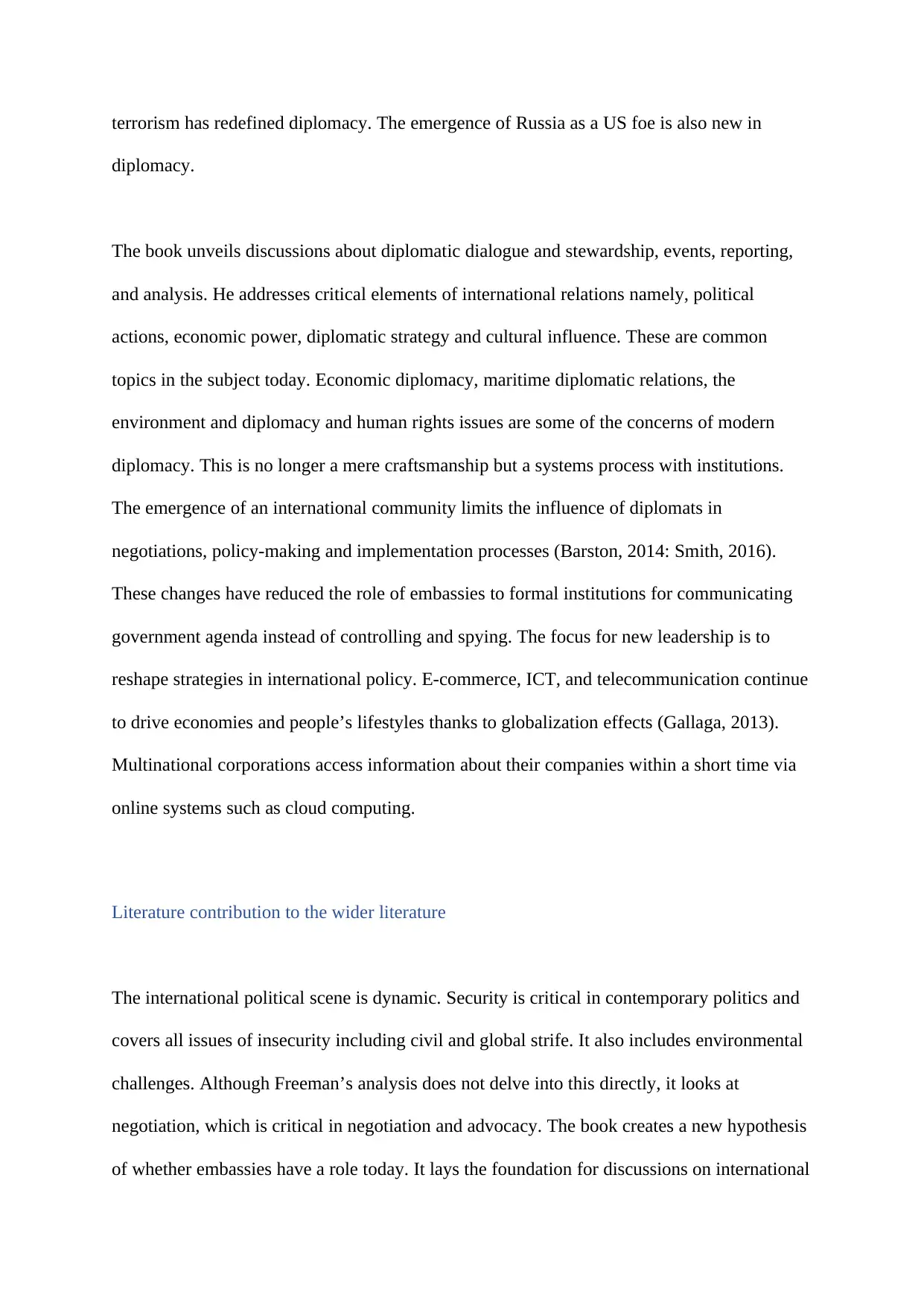
terrorism has redefined diplomacy. The emergence of Russia as a US foe is also new in
diplomacy.
The book unveils discussions about diplomatic dialogue and stewardship, events, reporting,
and analysis. He addresses critical elements of international relations namely, political
actions, economic power, diplomatic strategy and cultural influence. These are common
topics in the subject today. Economic diplomacy, maritime diplomatic relations, the
environment and diplomacy and human rights issues are some of the concerns of modern
diplomacy. This is no longer a mere craftsmanship but a systems process with institutions.
The emergence of an international community limits the influence of diplomats in
negotiations, policy-making and implementation processes (Barston, 2014: Smith, 2016).
These changes have reduced the role of embassies to formal institutions for communicating
government agenda instead of controlling and spying. The focus for new leadership is to
reshape strategies in international policy. E-commerce, ICT, and telecommunication continue
to drive economies and people’s lifestyles thanks to globalization effects (Gallaga, 2013).
Multinational corporations access information about their companies within a short time via
online systems such as cloud computing.
Literature contribution to the wider literature
The international political scene is dynamic. Security is critical in contemporary politics and
covers all issues of insecurity including civil and global strife. It also includes environmental
challenges. Although Freeman’s analysis does not delve into this directly, it looks at
negotiation, which is critical in negotiation and advocacy. The book creates a new hypothesis
of whether embassies have a role today. It lays the foundation for discussions on international
diplomacy.
The book unveils discussions about diplomatic dialogue and stewardship, events, reporting,
and analysis. He addresses critical elements of international relations namely, political
actions, economic power, diplomatic strategy and cultural influence. These are common
topics in the subject today. Economic diplomacy, maritime diplomatic relations, the
environment and diplomacy and human rights issues are some of the concerns of modern
diplomacy. This is no longer a mere craftsmanship but a systems process with institutions.
The emergence of an international community limits the influence of diplomats in
negotiations, policy-making and implementation processes (Barston, 2014: Smith, 2016).
These changes have reduced the role of embassies to formal institutions for communicating
government agenda instead of controlling and spying. The focus for new leadership is to
reshape strategies in international policy. E-commerce, ICT, and telecommunication continue
to drive economies and people’s lifestyles thanks to globalization effects (Gallaga, 2013).
Multinational corporations access information about their companies within a short time via
online systems such as cloud computing.
Literature contribution to the wider literature
The international political scene is dynamic. Security is critical in contemporary politics and
covers all issues of insecurity including civil and global strife. It also includes environmental
challenges. Although Freeman’s analysis does not delve into this directly, it looks at
negotiation, which is critical in negotiation and advocacy. The book creates a new hypothesis
of whether embassies have a role today. It lays the foundation for discussions on international
⊘ This is a preview!⊘
Do you want full access?
Subscribe today to unlock all pages.

Trusted by 1+ million students worldwide
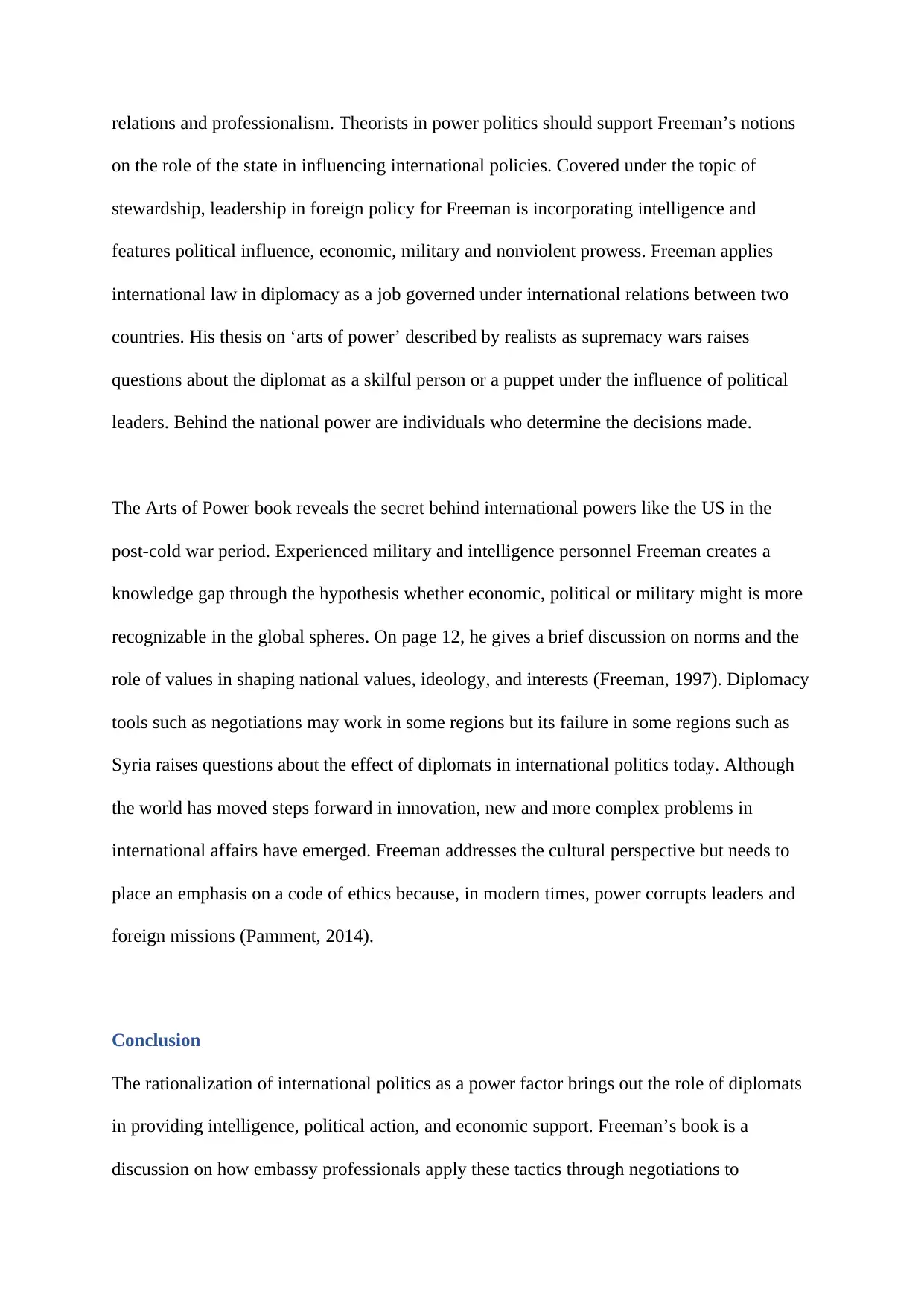
relations and professionalism. Theorists in power politics should support Freeman’s notions
on the role of the state in influencing international policies. Covered under the topic of
stewardship, leadership in foreign policy for Freeman is incorporating intelligence and
features political influence, economic, military and nonviolent prowess. Freeman applies
international law in diplomacy as a job governed under international relations between two
countries. His thesis on ‘arts of power’ described by realists as supremacy wars raises
questions about the diplomat as a skilful person or a puppet under the influence of political
leaders. Behind the national power are individuals who determine the decisions made.
The Arts of Power book reveals the secret behind international powers like the US in the
post-cold war period. Experienced military and intelligence personnel Freeman creates a
knowledge gap through the hypothesis whether economic, political or military might is more
recognizable in the global spheres. On page 12, he gives a brief discussion on norms and the
role of values in shaping national values, ideology, and interests (Freeman, 1997). Diplomacy
tools such as negotiations may work in some regions but its failure in some regions such as
Syria raises questions about the effect of diplomats in international politics today. Although
the world has moved steps forward in innovation, new and more complex problems in
international affairs have emerged. Freeman addresses the cultural perspective but needs to
place an emphasis on a code of ethics because, in modern times, power corrupts leaders and
foreign missions (Pamment, 2014).
Conclusion
The rationalization of international politics as a power factor brings out the role of diplomats
in providing intelligence, political action, and economic support. Freeman’s book is a
discussion on how embassy professionals apply these tactics through negotiations to
on the role of the state in influencing international policies. Covered under the topic of
stewardship, leadership in foreign policy for Freeman is incorporating intelligence and
features political influence, economic, military and nonviolent prowess. Freeman applies
international law in diplomacy as a job governed under international relations between two
countries. His thesis on ‘arts of power’ described by realists as supremacy wars raises
questions about the diplomat as a skilful person or a puppet under the influence of political
leaders. Behind the national power are individuals who determine the decisions made.
The Arts of Power book reveals the secret behind international powers like the US in the
post-cold war period. Experienced military and intelligence personnel Freeman creates a
knowledge gap through the hypothesis whether economic, political or military might is more
recognizable in the global spheres. On page 12, he gives a brief discussion on norms and the
role of values in shaping national values, ideology, and interests (Freeman, 1997). Diplomacy
tools such as negotiations may work in some regions but its failure in some regions such as
Syria raises questions about the effect of diplomats in international politics today. Although
the world has moved steps forward in innovation, new and more complex problems in
international affairs have emerged. Freeman addresses the cultural perspective but needs to
place an emphasis on a code of ethics because, in modern times, power corrupts leaders and
foreign missions (Pamment, 2014).
Conclusion
The rationalization of international politics as a power factor brings out the role of diplomats
in providing intelligence, political action, and economic support. Freeman’s book is a
discussion on how embassy professionals apply these tactics through negotiations to
Paraphrase This Document
Need a fresh take? Get an instant paraphrase of this document with our AI Paraphraser
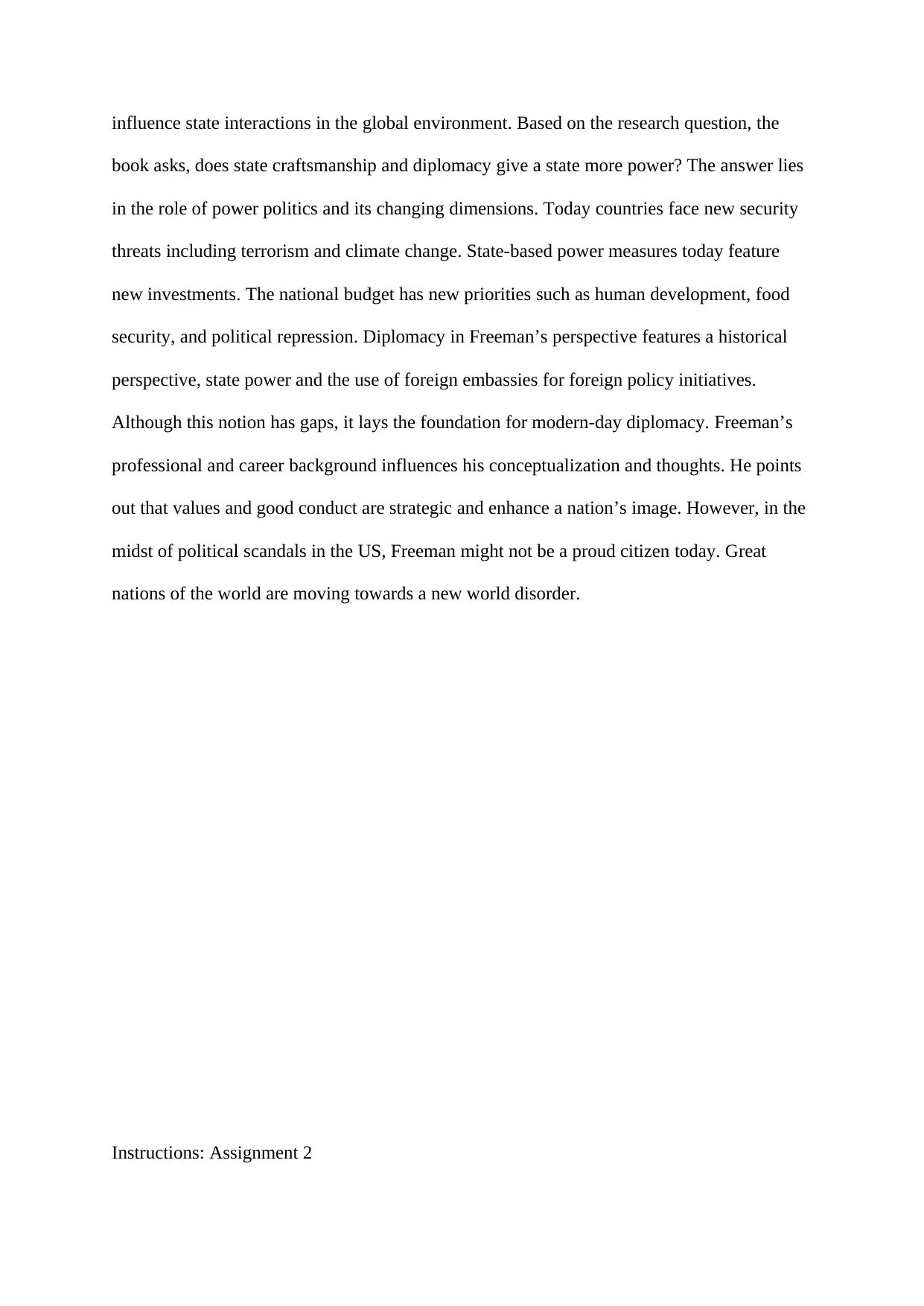
influence state interactions in the global environment. Based on the research question, the
book asks, does state craftsmanship and diplomacy give a state more power? The answer lies
in the role of power politics and its changing dimensions. Today countries face new security
threats including terrorism and climate change. State-based power measures today feature
new investments. The national budget has new priorities such as human development, food
security, and political repression. Diplomacy in Freeman’s perspective features a historical
perspective, state power and the use of foreign embassies for foreign policy initiatives.
Although this notion has gaps, it lays the foundation for modern-day diplomacy. Freeman’s
professional and career background influences his conceptualization and thoughts. He points
out that values and good conduct are strategic and enhance a nation’s image. However, in the
midst of political scandals in the US, Freeman might not be a proud citizen today. Great
nations of the world are moving towards a new world disorder.
Instructions: Assignment 2
book asks, does state craftsmanship and diplomacy give a state more power? The answer lies
in the role of power politics and its changing dimensions. Today countries face new security
threats including terrorism and climate change. State-based power measures today feature
new investments. The national budget has new priorities such as human development, food
security, and political repression. Diplomacy in Freeman’s perspective features a historical
perspective, state power and the use of foreign embassies for foreign policy initiatives.
Although this notion has gaps, it lays the foundation for modern-day diplomacy. Freeman’s
professional and career background influences his conceptualization and thoughts. He points
out that values and good conduct are strategic and enhance a nation’s image. However, in the
midst of political scandals in the US, Freeman might not be a proud citizen today. Great
nations of the world are moving towards a new world disorder.
Instructions: Assignment 2
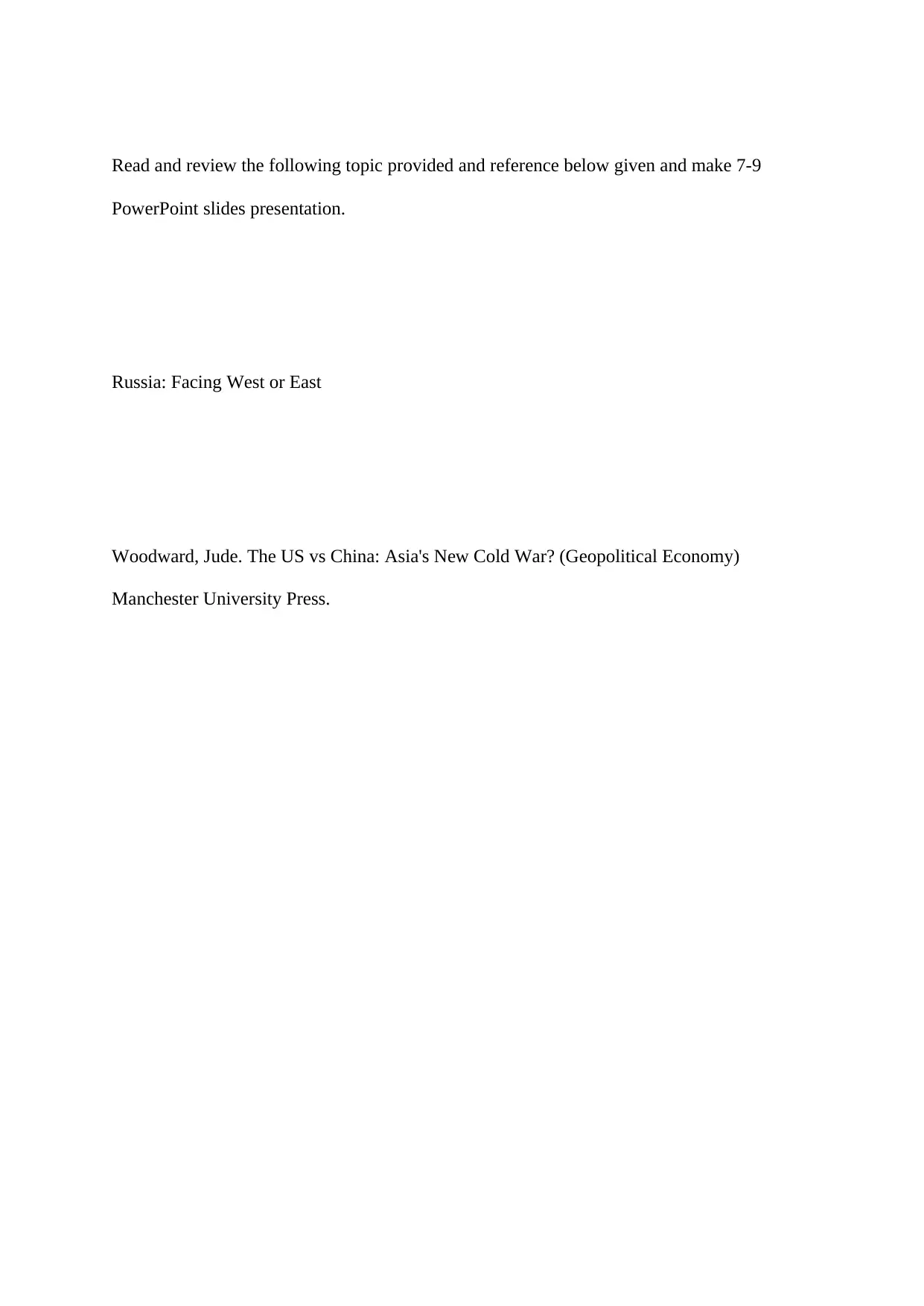
Read and review the following topic provided and reference below given and make 7-9
PowerPoint slides presentation.
Russia: Facing West or East
Woodward, Jude. The US vs China: Asia's New Cold War? (Geopolitical Economy)
Manchester University Press.
PowerPoint slides presentation.
Russia: Facing West or East
Woodward, Jude. The US vs China: Asia's New Cold War? (Geopolitical Economy)
Manchester University Press.
⊘ This is a preview!⊘
Do you want full access?
Subscribe today to unlock all pages.

Trusted by 1+ million students worldwide
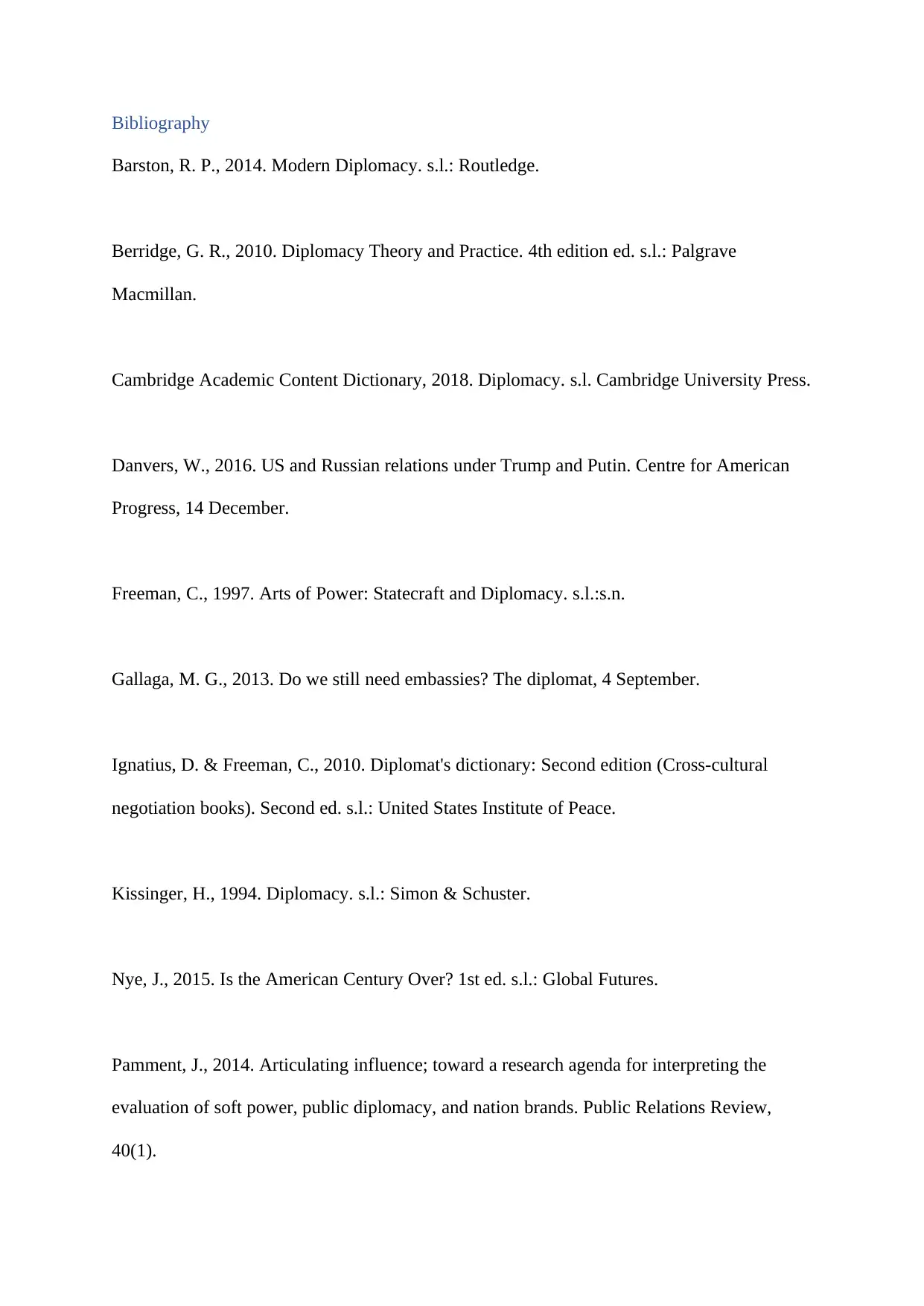
Bibliography
Barston, R. P., 2014. Modern Diplomacy. s.l.: Routledge.
Berridge, G. R., 2010. Diplomacy Theory and Practice. 4th edition ed. s.l.: Palgrave
Macmillan.
Cambridge Academic Content Dictionary, 2018. Diplomacy. s.l. Cambridge University Press.
Danvers, W., 2016. US and Russian relations under Trump and Putin. Centre for American
Progress, 14 December.
Freeman, C., 1997. Arts of Power: Statecraft and Diplomacy. s.l.:s.n.
Gallaga, M. G., 2013. Do we still need embassies? The diplomat, 4 September.
Ignatius, D. & Freeman, C., 2010. Diplomat's dictionary: Second edition (Cross-cultural
negotiation books). Second ed. s.l.: United States Institute of Peace.
Kissinger, H., 1994. Diplomacy. s.l.: Simon & Schuster.
Nye, J., 2015. Is the American Century Over? 1st ed. s.l.: Global Futures.
Pamment, J., 2014. Articulating influence; toward a research agenda for interpreting the
evaluation of soft power, public diplomacy, and nation brands. Public Relations Review,
40(1).
Barston, R. P., 2014. Modern Diplomacy. s.l.: Routledge.
Berridge, G. R., 2010. Diplomacy Theory and Practice. 4th edition ed. s.l.: Palgrave
Macmillan.
Cambridge Academic Content Dictionary, 2018. Diplomacy. s.l. Cambridge University Press.
Danvers, W., 2016. US and Russian relations under Trump and Putin. Centre for American
Progress, 14 December.
Freeman, C., 1997. Arts of Power: Statecraft and Diplomacy. s.l.:s.n.
Gallaga, M. G., 2013. Do we still need embassies? The diplomat, 4 September.
Ignatius, D. & Freeman, C., 2010. Diplomat's dictionary: Second edition (Cross-cultural
negotiation books). Second ed. s.l.: United States Institute of Peace.
Kissinger, H., 1994. Diplomacy. s.l.: Simon & Schuster.
Nye, J., 2015. Is the American Century Over? 1st ed. s.l.: Global Futures.
Pamment, J., 2014. Articulating influence; toward a research agenda for interpreting the
evaluation of soft power, public diplomacy, and nation brands. Public Relations Review,
40(1).
Paraphrase This Document
Need a fresh take? Get an instant paraphrase of this document with our AI Paraphraser
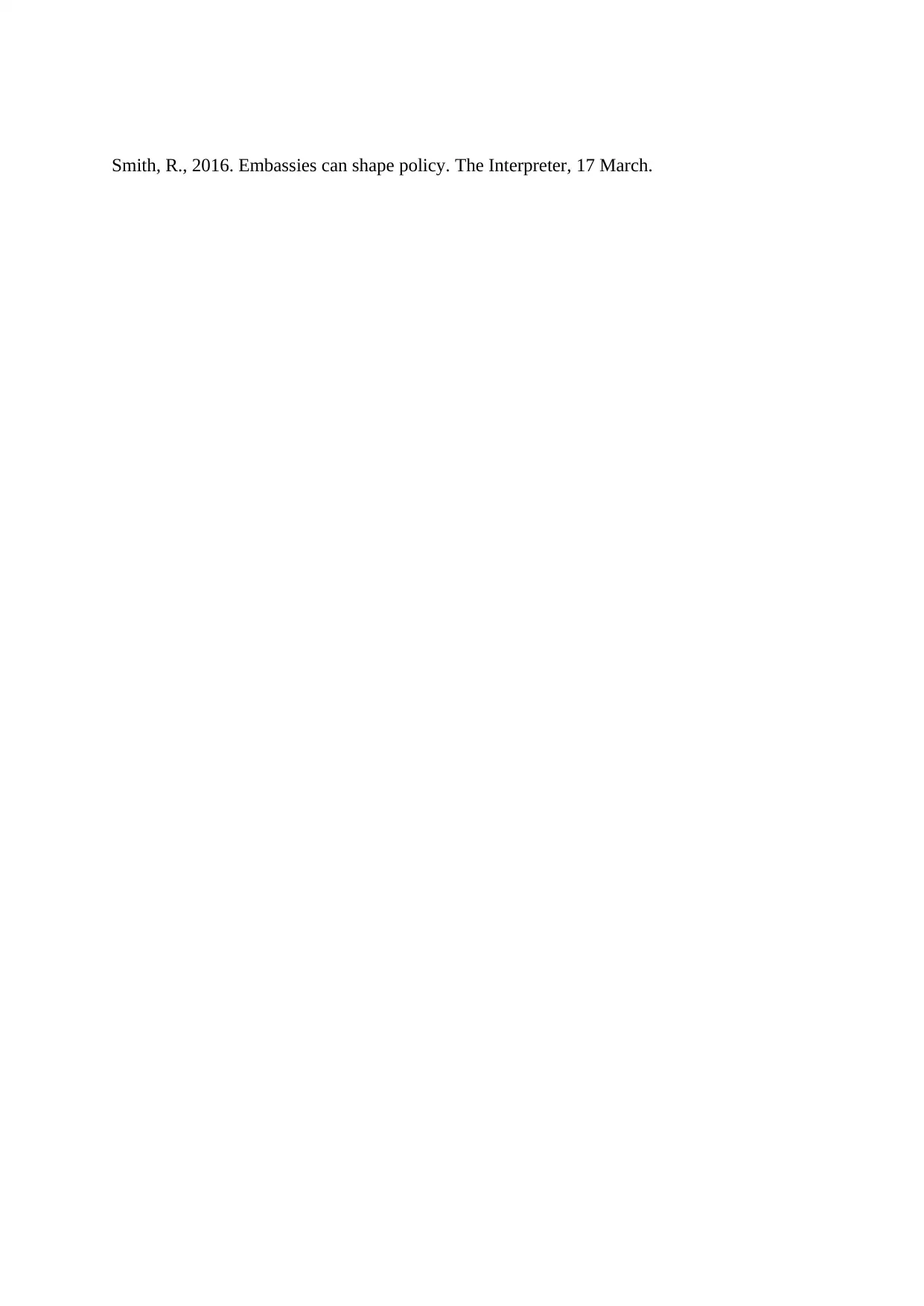
Smith, R., 2016. Embassies can shape policy. The Interpreter, 17 March.
1 out of 11
Your All-in-One AI-Powered Toolkit for Academic Success.
+13062052269
info@desklib.com
Available 24*7 on WhatsApp / Email
![[object Object]](/_next/static/media/star-bottom.7253800d.svg)
Unlock your academic potential
Copyright © 2020–2025 A2Z Services. All Rights Reserved. Developed and managed by ZUCOL.
